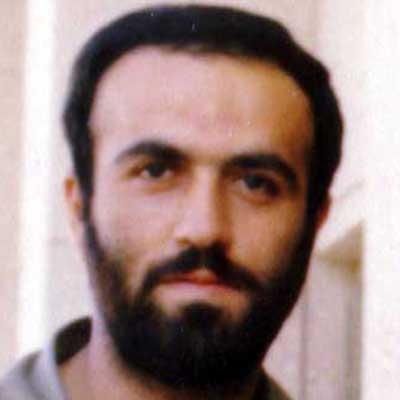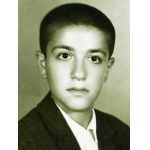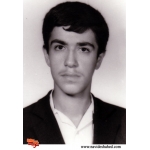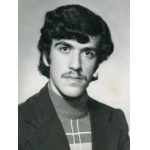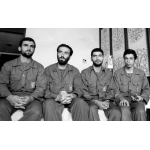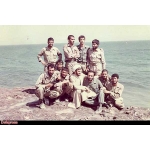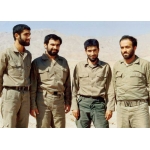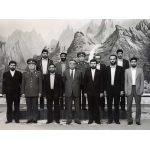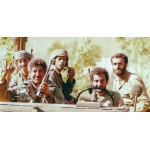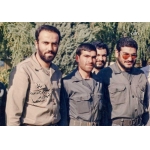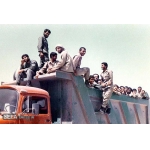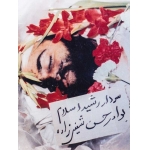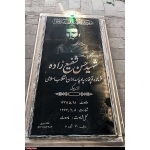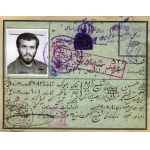Shafizadeh, Hassan
Milad Shavikloo
343 بازدید
Hassan Shafizadeh (1957–1987) was one of the founders of the Islamic Revolutionary Guard Corps (IRGC) in Tabriz and served as the commander of the IRGC’s artillery unit during the Iran-Iraq War.
Born in 1957 into a religious family in Tabriz, Hassan Shafizadeh lost his father when he was twelve years old. After finishing high school, he was conscripted into military service. During the rise of the Islamic Revolution, Shafizadeh established contact with prominent clerics such as Ayatollah Madani and Ayatollah Dastgheib, who were in exile at the time. While completing his mandatory military service, he engaged in various activities aimed at raising awareness among soldiers and countering the propaganda campaigns of the Pahlavi regime. He also distributed leaflets containing the messages and statements of Imam Khomeini (ra) both inside and outside the garrison. When the regime’s agents planned a raid on Ayatollah Madani’s house, Shafizadeh and his friends prepared to confront them during Ashura mourning ceremonies. However, before they could act, the regime’s counterintelligence unit discovered their plans, and they were exiled to Marand.[1]
After the Revolution, Shafizadeh, along with several students from Tabriz, organized an armed group to prevent anti-revolutionary elements from accessing military weapons that had fallen into the hands of the public and to capture SAVAK agents. He also organized military training classes at Ayatollah Aghanji Mosque. Along with other revolutionary forces, he laid the foundation for the “Sepah-e Towhidi.” Later, when the IRGC was officially established in Tabriz, Sepah-e Towhidi was integrated into the new structure, with Shafizadeh playing an active role as the head of operations in suppressing feudal lords, bandits in Azerbaijan, and the People’s Muslim Party. During the chaos and tension caused by the People’s Muslim Party, Shafizadeh, along with Abulhassan Aal-Eshaq and fellow IRGC members, took extraordinary measures to resist them, eventually liberating strategic locations such as the state TV and radio station, which had been seized by the opposition (Munafiqeen Group).[2]
Due to his deep respect for Ayatollah Madani, Shafizadeh took on the responsibility of protecting his residence. However, he soon moved to Urmia, where, alongside Mahdi Bakeri, he joined the IRGC forces in the city to safeguard the Revolution’s achievements and combat bandits. He played a pivotal role in securing border regions, including areas such as Sarv, Soltani, Hasanlou, Shapiran, Targour, Oshnaviyeh, Kaloran, Bardak, and Soumay.[3]
With the onset of the Iran-Iraq War and the siege of Abadan, Shafizadeh and a mortar platoon led by Mahdi Bakeri quickly joined the forces on the southern front. He played a historic role in breaking the siege of Abadan and repelling the Baathist invaders. After Operation Tariq al-Quds, Shafizadeh was appointed Chief of Staff of the newly formed Karbala Brigade, where he played a key role in its organization. Following Operation Fath al-Mobin, during which he served as the deputy commander of the Al-Mahdi (as) Brigade, Shafizadeh, along with several other commanders, laid the groundwork for organizing the first artillery units. He also took on the responsibility of coordinating and providing artillery support at Fath Headquarters during Operation Beit al-Muqaddas.[4]
Initially, the IRGC had no artillery unit. During the first and second years of the war, with the coordination of the Army, a number of forces were sent to artillery positions for hands-on training. As a result, several 105 mm cannons were provided to the IRGC. However, during operations, Tariq al-Quds, Fath al-Mobin, and Beit al-Muqaddas, many 152 mm and 130 mm cannons were captured from Iraqi forces, and thus the IRGC’s Artillery Unit was formally established on April 4, 1983, with the collaboration of Hassan Shafizadeh.[5]
In early 1985, after Operation Badr, the Commander-in-Chief of the IRGC appointed Hassan Shafizadeh, who was already serving as the commanding officer of the IRGC’s Artillery Unit, as the head of the Artillery Training Center. Shafizadeh began organizing the recruitment of personnel and the establishment of various technical departments and committees.[6] His artillery unit played a decisive role in Operation Valfajr 8.[7]
Hassan Shafizadeh was martyred on April 28, 1987, in the operational area of Karbala 10 in Mawot, Iraq, when a shell struck his vehicle.[8] He is buried in the Martyrs’ Cemetery in Wadi Rahmat, Tabriz.[9]
[1] Najafi, Hossein, A short account of the life and great epics of the General of the Revolutionary Guards, Major General Hassan Shafizadeh, Tabriz: General Directorate for Preservation of Works and Publication of the Values of Sacred Defense of East Azerbaijan, 2007, pp. 2-4.
[2] Soleimanikia, Jafar, Najafi, Hossein, Ashenay Aseman (Familiar with the Sky), Tabriz: Headquarters of the Congress of Martyrs and Martyr Generals of East Azerbaijan, Vol. 2: 2005, pp. 25 and 26.
[3] Soleimanikia, Jafar, Najafi, Hossein, Ashenay Aseman (Familiar with the Sky), p. 30, Najafi, Hossein, A short account of the life and great epics of the General of the Revolutionary Guards, Major General Hassan Shafizadeh, p. 4.
[4] Najafi, Hossein, A short account of the life and great epics of the General of the Revolutionary Guards, Major General Hassan Shafizadeh, pp. 4 and 5.
[5] Asadi, Heybatollah, Aatashe Toopkhaneh (Artillery Fire), Tehran: Dafos Aja, 2015, p. 355.
[6] Ibid; p. 367.
[7] Soleimanikia, Jafar, Najafi, Hossein, Ashenay Aseman (Familiar with the Sky), p. 82.
[8] Najafi, Hossein, Osve haye Mandeghar (Enduring Examples), Tabriz: Foundation for the Preservation of Works and Publication of Values of the Sacred Defense of East Azerbaijan, 2005, p. 78.
[9] Encyclopedia of Martyrs and Veterans of the Islamic Republic of Iran https://mazareshahid.ir/61655.


